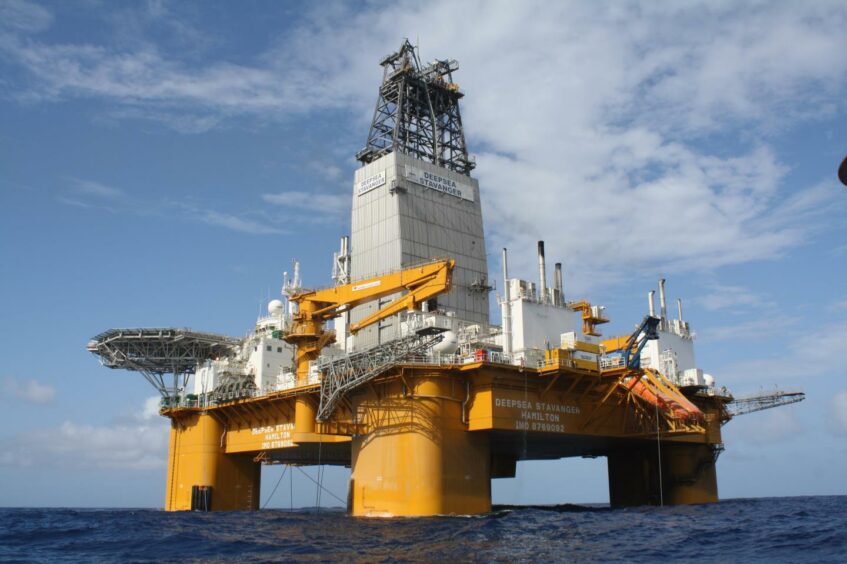
Westwood Global Energy reports that there were three exploration wells active as of 24 January. One exploration well has spudded and completed in 2022.
At year end 2021, 29 exploration and six appraisal wells had completed, with a further three exploration wells that still had operations ongoing. This compares to 25 exploration and two appraisal wells completed in 2020. Twenty-eight exploration and six appraisal programmes spudded in 2021.
North Sea
Wellesley spudded the 36/1-4 Hemispheres exploration well on 18 December with the Borgland Dolphin semi sub. The well is targeting oil and gas in shallow marine sandstones of the Middle Jurassic Krossfjord Fm, in a faulted three-way dip closure. The well was expected to drill in Q3 2020 but was deferred to 2021 – 2022 following Covid-19 pandemic. The well is located c. 50 km to the north of the Duva field and has a c. 33-day dry hole duration.
Aker BP spudded the 25/2-23 S, A Grefsenkollen / Øst Frigg exploration well on 24 December with the Deepsea Nordkapp semi sub. The initial well is thought to have targeted remaining resources in the oil and gas cap of the decommissioned Eocene Øst Frigg/East Frigg structure. The 25/2-23 A sidetrack, which kicked off on 4 January, is targeting the Middle Jurassic Tarbert Formation reservoir in the Grefsenkollen gas condensate prospect. The well is located over the eastern part of the Øst Frigg decommissioned field and has a c. 92-day dry hole duration, plus an additional 12 days to do a further sidetrack.
Equinor completed the 35/10-7 S, A Toppand exploration well on 27 December with the West Hercules semi sub having spudded on 2 November and sidetracked on 12 December. The well was targeting oil in a faulted structural trap in the Middle Jurassic Etive and Oseberg Formations in the Brent Group and the Lower Jurassic Cook Formation in the Dunlin Group. The well made a commercial oil discovery. The initial well 35/10-7 S encountered a c. 75m (246ft) oil column in the Middle Jurassic lower Ness and Etive Formations. The Oseberg Formation was c. 48m (157ft) thick and water wet. The OWC was estimated by pressure data to be 3,303m (10,837ft) TVDSS. The updip sidetrack 35/10-7 A encountered a 60m (197ft) oil column in the Ness and Etive Formations. A 30m (98ft) oil column was encountered in the Oseberg Formation with a OWC proven at 3,290m (10,794ft) TVDSS. The Lower Jurassic Cook Formation was dry in both wells. Development is expected to be a tie back to the Troll field.
Norwegian Sea
Equinor spudded the 6407/9-13 Ginny / Hermine exploration well on 31 December with the West Hercules semi sub. The well is targeting oil and gas in Upper – Middle Jurassic sandstones within a tilted fault block. The primary Ginny prospect is in the Upper Jurassic Rogn and Melke Formations. The secondary Hermine prospect is in the Middle Jurassic Garn and Ile Formations. The well is located c. 10 km to the northwest of the Draugen field which would be the most likely tie back solution if a commercial oil discovery was made whilst gas could be tied back via the Hasselmus field which is located between the two. The well has a c. 32-day dry hole duration.
Lundin Energy completed the 6306/9-1 Melstein exploration well on 18 January with the Deepsea Stavanger semi sub, having spudded on 3 January. The well was targeting stratigraphically trapped Upper Jurassic sandstones of the Rogn Formation and Pre-Devonian Basement associated with a tilted fault block structure, within the southern crestal part of the Frøya High. The well was planned for 2020 but deferred due to Covid-19 to 2021, then deferred further to 2022. The well encountered 73m (243ft) of Upper Jurassic Rogn Formation reservoir, a further 25m (82ft) reservoir of unknown age and 76m (249ft) of tight Basement. All reservoirs were water bearing with no traces of hydrocarbons.
Barents Sea
There is no current E&A drilling in the Barents Sea. The next exploration well in the region is expected to be on Equinor’s 7220/8-2 S Snøfonn Nord prospect in Q1 2022.
Recommended for you
